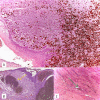Anorectal Mucosal Melanoma: A Case Report and Literature Review
- PMID: 34699518
- PMCID: PMC8557858
- DOI: 10.12659/AJCR.933032
Anorectal Mucosal Melanoma: A Case Report and Literature Review
Abstract
BACKGROUND Anorectal mucosal melanoma (AMM) is a rare and aggressive neoplasm, with a 5-year survival rate of 10%. Due to its rarity and nonspecific symptoms, the diagnosis is often made late. Surgical resection remains the criterion standard for treatment of anorectal melanoma. CASE REPORT We present the case of an 81-year-old woman presenting with hematochezia, anal secretion, tenesmus, difficulty in defecation, and perianal pain. On physical examination, there was a prolapse of a 5-cm melanocytic nodule in the anal canal, hard on palpation. Biopsy confirmed anorectal melanoma. Staging revealed anal and metastatic disease, with adrenal, lymphatic, and hepatic involvement. As the patient continued to have bleeding, severe pain, and difficulty in defecation, she was submitted to a wide local excision. At 5-month follow-up, the anal lesion had relapsed, and the patient died 10 months after the procedure. CONCLUSIONS AMM is a rare and extremely aggressive tumor. Symptoms are nonspecific but early diagnosis should be pursued to allow curative treatment. Surgical resection with free margins is the goal of surgical treatment. New therapies are being studied, including immunotherapy, which can improve the dismal prognosis of this rare disease.
Conflict of interest statement
Figures




References
-
- Chang AE, Karnell LH, Menck HR. The National Cancer Data Base report on cutaneous and noncutaneous melanoma: A summary of 84,836 cases from the past decade. The American College of Surgeons Commission on Cancer and the American Cancer Society. Cancer. 1998;83(8):1664–78. - PubMed
-
- Thibault C, Sagar P, Nivatvongs S, et al. Anorectal melanoma – an incurable disease? Dis Colon Rectum. 1997;40(6):661–68. - PubMed
-
- Beadling C, Jacobson-Dunlop E, Hodi FS, et al. KIT gene mutations and copy number in melanoma subtypes. Clin Cancer Res. 2008;14:6821–28. - PubMed
Publication types
MeSH terms
LinkOut - more resources
Full Text Sources
Medical
Research Materials

